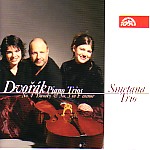This is the Smetana Trio playing Dvorák, not to be confused with the Dvorák Trio playing Smetana. Such is life in the world of Czech chamber music. But seriously, Supraphon alone has an abundance of recordings of these works, and no wonder. The F minor and Dumky trios probably are the two finest works in the trio medium from the second half of the 19th century, and they make ideal disc-mates, one a sort of apotheosis of Dvorák’s work in traditional forms, the other an innovative and path-breaking essay in his popular nationalist idiom. This stupendous new recording rivals the celebrated Suk Trio interpretations for the same label both in technical mastery and interpretive insight; in short, it is second to none.
The program opens with the Dumky Trio, and right from the start you can tell that this is going to be a great performance. Passion and spontaneity unite with rhythmic precision and a real feeling for the dance. Listen to the natural rubato in the fourth movement that prevents the recurring march rhythms from ever turning stiff or mechanical (and notice how much this music resembles the finale of Shostakovich’s Second Trio). I loved the lightness of rhythm in the next piece: so often its skipping 6/8 rhythm becomes an excuse to create a chamber version of Wagner’s descent into Nibelheim. Not here, where careful attention to dynamics and a flowing tempo create an effortless feeling of movement. There isn’t a second in this performance where you feel the music should be played any other way, and no praise can be higher than that.
If anything, these qualities are even more evident in the great F minor trio. The players fling themselves into the first movement with almost dangerous abandon–but notice how perfectly in tune the opening octaves are, and how perfectly balances are maintained even in the most turbulent episodes in the development section. As in the previous work, the scherzo benefits from the ensemble’s rhythmic acuity; but it’s the slow movement that’s really special here. It’s not only beautifully paced and phrased, but the ensemble obviously took as much care with transitions as with the melodies, and the result has a seamless continuity that belies the impression in less-adept performances of a movement consisting of a disjointed stream of incredibly pretty tunes.
In the finale, happily taking Dvorák’s “con brio” admonition literally, the ensemble sails into the coda with such enthusiasm that the music seems self-propelled. The final turn to the major in the coda is absolutely thrilling, and the closing bars offer the ultimate in musical satisfaction. I started listening to this disc with the slow movement, thinking to sample a bit here and there, but the playing was so gripping that I played the disc through to the end, then went back and listened again from the beginning. It’s that good, and the sonics have a true-to-life immediacy that permits these spellbinding interpretations to register with maximum impact. Without question, this is a very great recording, an essential acquisition whether you already love this music or just want to get to know it better. [6/16/2006]
































